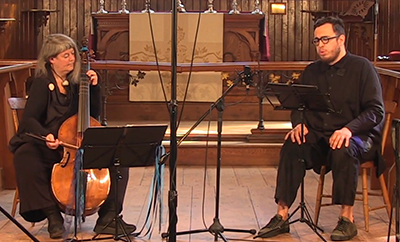by Jarrett Hoffman

Les Délices’ virtual SalonEra series continues tonight at 7:30 with “Recovering Roots,” featuring Cree-Métis baritone Jonathon Adams and violist da gamba Mélisande Corriveau. With music from the Métis Songbook and works by Marais, Purcell, and J.S. Bach, the program is billed as “a personal journey to reconnect to Indigenous roots while recovering a history of cultural exchange and musical migration in late 17th- and 18th-century New France.” It’s free, but a $10 donation is suggested. Click here at start time.
INTERESTING READ:
As Melinda Bargreen wrote in The Seattle Times, “There’s never been an opening night like this one.” The Seattle Symphony began its season on September 19 with a drive-in screening of a concert that had been recorded earlier in the week, with the music channeled into cars through the FM dial. Read more here.
TODAY’S ALMANAC:
September 21 presents an interesting criss-cross of British and American music history. Let’s start with English organist and composer John Stafford Smith, who died in London on this date in 1836, and who wrote To Anacreon in Heaven.
If that doesn’t mean anything to you yet, hold tight: that official song of the Anacreontic Society, a London-based gentleman’s club of amateur musicians, was later joined with Francis Scott Key’s 1814 poem The Defence of Fort M’Henry to become The Star-Spangled Banner.
There are conflicting accounts about the date To Anacreon in Heaven was composed, but Smith likely wrote it in the 1770s, perhaps ‘73 or ‘76. (If it was 1776, the same year when the Declaration of Independence was issued on July 4, that sure would be a nice and ironic cherry on top for the story of America — if it’s not ironic enough already that our national anthem includes a British melody.)
Taking that story a little bit further, American statesman, author, and composer Francis Hopkinson was born on this day in 1737 (that’s according to the old style of dates, before the shift to the Gregorian calendar in the 1750s). Not only was Hopkinson one of the signers of the Declaration of Independence, among his many positions of leadership in the birth of the U.S., but he also contributed to the musical life of 18th-century Philadelphia in several ways.
Hopkinson was a harpsichordist and organist, and composed the earliest surviving American secular piece of music (the song “My Days have been so Wondrous Free”). And of most relevance here, he wrote one of the early parodies of To Anacreon in Heaven — in a way, setting the stage for the original text to be switched out for Key’s poem down the line.
Connecting all of this to Northeast Ohio is a 2014 performance by Quire Cleveland and founder Ross Duffin. As he told us in April of that year, there are no choral arrangements of The Star-Spangled Banner until the mid-19th century. “And to my surprise,” Duffin said, “there are four stanzas in the original.”
As Daniel Hathaway wrote in the preview article, Duffin’s four-part choral arrangement of The Star-Spangled Banner draws both on a solo song version with accompaniment and on that original glee, To Anacreon in Heaven. Listen to Quire’s 2014 performance at Historic St. Peter’s Church here on YouTube.


